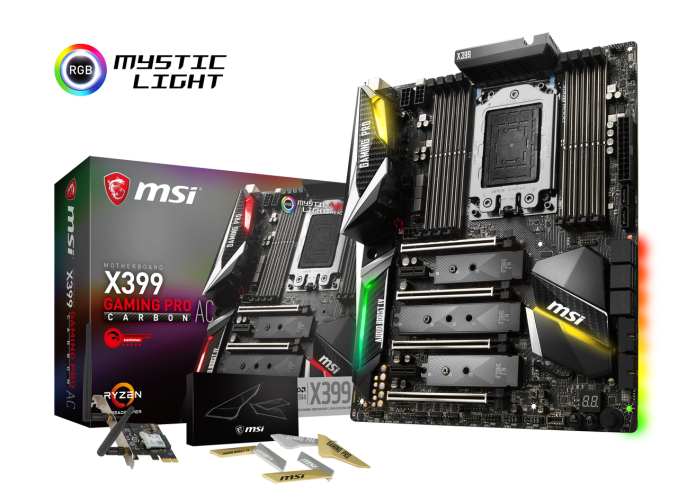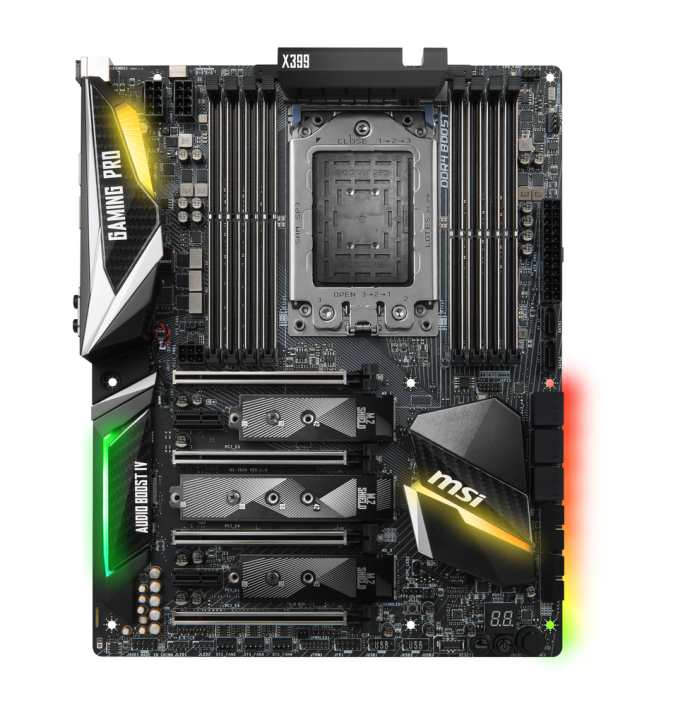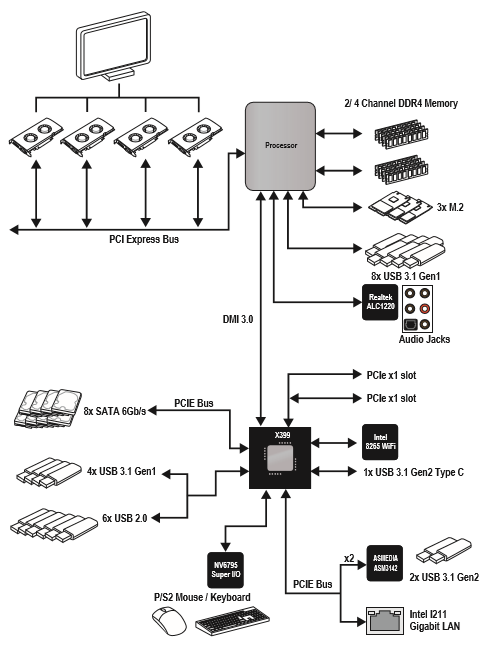An AMD Threadripper X399 Motherboard Overview: A Quick Look at Seven Products
by Ian Cutress & Joe Shields on September 15, 2017 9:00 AM ESTMSI
MSI's initial offering in the X399 space comes in the form of Gaming Pro Carbon AC. This board sits as the high-end board within the Performance Gaming lineup in previous generations. The Gaming Pro Carbon series tends to features for gamers and enthusiasts, using modern audio codecs, wireless capabilities, and aiming for high overclocking abilities.
The MSI X399 Gaming Pro Carbon AC
Starting with the DRAM, we see eight slots covered with MSI's Steel Armor. Memory capacity is the same as other boards, holding up to 128GB in a quad channel configuration, and MSI promotes a maximum supported speed of DDR4-3600, although higher might be possible through overclocking further. MSI is promoting its DDR4 Boost technology, which they say optimizes the traces and fully isolates the memory circuitry for increased stability and performance.
Power delivery for the X399 Gaming Pro Carbon AC is handled by International Rectifier based DrMOS ICs. These are likely either IR3556 or IR 3555 PowIRstages, so either 50A or 60A each. The controller is said to be the IR35201. Power is fed to the VRM by 2x 8-pin 12V CPU (one is optional) located in the upper left-hand corner between the memory slots and rear I/O area. The board has an 8 layer PCB design which MSI mentions is designed to increase efficiency and stability over a standard PCB (it is worth noting that no-one uses a 'standard PCB' for X399). Preaching top quality and stability again, MSI's states its Titanium-II chokes, Dark Caps, and Dark Chokes are 'Military Class 6' certified. The VRM heatsink is unusually tall, to negate the fact it is not connected to anything, but is made out aluminum.
Moving down the board a bit, we can identify four full-length PCIe slots also protected by MSI's Steel Armor surrounding the slots. The Gaming Pro Carbon AC supports 4-Way SLI/Crossfire. In addition to the four full-length connections are two PCIe 2.0 x1 slots fed from the chipset.
For storage purposes, the motherboard has a total of eight SATA ports, six of which are horizontally mounted, while the other two are vertical. There are three M.2 slots also, all of them supporting both PCIe 3.0 x4 drives and SATA drives. Two of the three slots can hold up to a 80mm drives, while the middle M.2 can hold a 110mm drive. All the M.2 ports are nestled between PCIe slots, and use an 'M.2 Shield' to aid with heat dissipation. Unlike some of the other boards, U.2 does not make an appearance on the Gaming Pro Carbon.
Audio output is handled by the Realtek ALC1220 codec working with MSI's Audio Boost 4 suite. MSI updated the Nahimic sound technology to Nahimic 2+, and is now able to apply its audio effects through S/PDIF and Optical connections for non-encoded formats. There is also a dedicated headphone amplifier which auto-detects impedance such that headphones up to 600Ω can be used. The Gaming Pro Carbon also features board isolation of the channels in separate layers of the PCB, filter caps, EMI protection on the audio processor itself (includes built-in DAC), as well as isolation of the audio circuitry from the rest of the motherboard.
RGB LEDs make an appearance on this board as well. Somewhere between the understated ASRock boards and well below the Gigabyte light show is where the Gaming Pro Carbon lands on the spectrum. We can see the LEDs on the rear I/O cover and above the audio on the left-hand side of the board, as well as the chipset heatsink. The last set of LEDs is located under the board below the SATA ports. The Pro Carbon also has two more headers for RGB strips. One for general RGB and the other a rainbow strip. MSI's Mystic Light software controls all the RGB LED functions including those connected to the headers.
MSI included a block diagram of how they break all the lanes down from the CPU and chipset to attached devices.
Below is a complete list of specifications.
| MSI X399 Gaming Pro Carbon | |
| Warranty Period | 3 Years |
| Product Page | Link |
| Price | $379.99 |
| Size | ATX |
| CPU Interface | TR4 |
| Chipset | AMD X399 |
| Memory Slots (DDR4) | Eight DDR4 Supporting 128GB Quad Channel Up to 3600 MHz (OC) Supports ECC UDIMM (in non-ECC mode) |
| Network Connectivity | 1 x Intel I211 Gigabit LAN controller |
| Onboard Audio | Realtek ALC1220 |
| PCIe Slots for Graphics (from CPU) | 4 x PCIe 3.0 x16 |
| PCIe Slots for Other (from Chipset) | 2 x PCIe 2.0 x1 |
| Onboard SATA | 8 x Supporting RAID 0/1/10 |
| Onboard SATA Express | None |
| Onboard M.2 | 3 x PCIe 3.0 x4 - NVMe or SATA |
| Onboard U.2 | None |
| USB 3.1 | 1 x Type-C (ASMedia) 1 x Type-A (ASMedia) 1 x Header (Chipset) |
| USB 3.0 | 8 x Rear Panel 2 x Header |
| USB 2.0 | 2 x Rear Panel 2 x Header |
| Power Connectors | 1 x 24-pin ATX 2 x 8-pin CPU 1 x 6-pin PCIe |
| Fan Headers | 1 x CPU (4-pin) 1 x Water Pump (4-pin) 4 x System Fan (4-pin) |
| IO Panel | 1 x Clear CMOS button 1 x BIOS FLASHBACK+ button 1 x PS/2 keyboard/mouse combo port 2 x USB 2.0 Type-A ports 8 x USB 3.0 Type-A ports 1 x LAN (RJ-45) 1 x USB 3.1 Type-A port 1 x USB 3.1 Type-C port 5 x Audio Jacks 1 x Optical S/PDIF OUT connector |

















99 Comments
View All Comments
LordanSS - Saturday, September 16, 2017 - link
My money is on the latter.... =/vgray35@hotmail.com - Friday, September 15, 2017 - link
With CPU power approaching 150 Amps, all these MBs are brain dead right out the gate, for using 50y old 8+ phase Buck converter topology, where VRMs with multiple phases still have poor response settling times (not one cycle settling but 20 cycles), lowish efficiencies way below 98% needing substantial heat sinks; while being saddled with the vagaries of inductive energy storage which takes up a lot of space and cost much more. Instead they should be using hybrid-PWM switching eliminating hard switch of high currents, where fractional cycle resonance ensures zero current switching and almost no switching losses. Resonance frequency scaling of the inductor/capacitor eliminates the need for ferrite cores altogether, reducing both size and core losses.http://www.powerelectronics.com/power-management/s...
Rehashing the same old power technologies with only stepwise minuscule improvements at each iteration, is not going to bode well at all. These engineers need to join the rest of us in the 21st century, and stop rehashing inductive energy storage solutions in power supplies. These new power topologies have been available for 5y to 8y now. And further this will also reduce EMI noise.
vgray35@hotmail.com - Friday, September 15, 2017 - link
I might add eliminating the multi-phase Buck converters for a solution based on PWM-resonance switching (hybrid switching), fractional cycle resonance (one cycle settling responses), and resonance scaling of resonance components, will likely permit a X399 mITX board to be made; with all that PSU space recovered for other purposes. Who will take up the challenge? AMD, ASROCK? Or will Intel beat AMD in the rush to high current capability at 99% efficiency? Or one of the other competitors out there! A clarion call to action this is to once and for all retire the Buck converter!ddriver - Friday, September 15, 2017 - link
I doubt they will even make a micro atx board, much less itx...It will be a waste, gigantic socket will take up most of the space, there won't be enough room for all 4 memory channels, the CPUs generous amount of PCIE lanes will be utterly wasted.
vgray35@hotmail.com - Friday, September 15, 2017 - link
Yes, and yet ASROCK put the X99 on a mITX board. However cutting heat from the VRM's by 60% to 70% or more should be done anyway, not to mention the graphics cards that draw even more power. Why settle for 95/96% efficiency (or worse in some cases) when one could get 98.5% to 99% efficiency. But then again you might be right concerning Thread Ripper, although I would still buy it with M2 slots on the back. The power delivery could be moved entirely to the back of the board without heat sinks with a total height of only 1.5mm (possibly at the center of socket itself on the back). The challenge of course is just as applicable to the graphics cards.ddriver - Saturday, September 16, 2017 - link
Hm, it seems that they launched some lga2066 boards recently, an asrock itx and an msi matx. TR4 however is still atx and up only...DanNeely - Friday, September 15, 2017 - link
I agree about how little sense it would make; but there have been a few LGA2011 mITX boards for people who only needed the higher core count. One of the two currently listed on Newegg uses SoDIMMs and riser boards around the CPU socket to make everything fit. Doing it for Threadripper would definitely be harder on account of the bigger socket; but I won't say never.Xajel - Saturday, September 16, 2017 - link
mITX is very hard even with riser boards & only 4x SO-DIMMsbut mATX on the other hand is very plausible... lets hope for a mATX version of the ASRock Pro Gaming with it's 10GbE ( and at least one of it's Intel's 1GbE ), at least 2 of it's M.2's and 6+ SATA ports... and please ASRock, add a front USB 3.1g2 header...
ddriver - Friday, September 15, 2017 - link
Amps, or amperes, is a unit of current, not a unit of power. Power is measured in watts."Rehashing the same old power technologies with only stepwise minuscule improvements at each iteration, is not going to bode well at all." - this is unfortunately a fact, and the de-fact motto of the industry.
ddriver - Friday, September 15, 2017 - link
I mean it is kinda naive to assume several years old switching circuits will find their way into the mainstream just because they are a few percent better.We've had gas turbine engines for decades, but they are still only used in tanks, helicopters or naval ships, while mainstream vehicles are still stuck with the internal combustion engine, which is easier to break, harder to maintain and a whooping 60% less efficient.